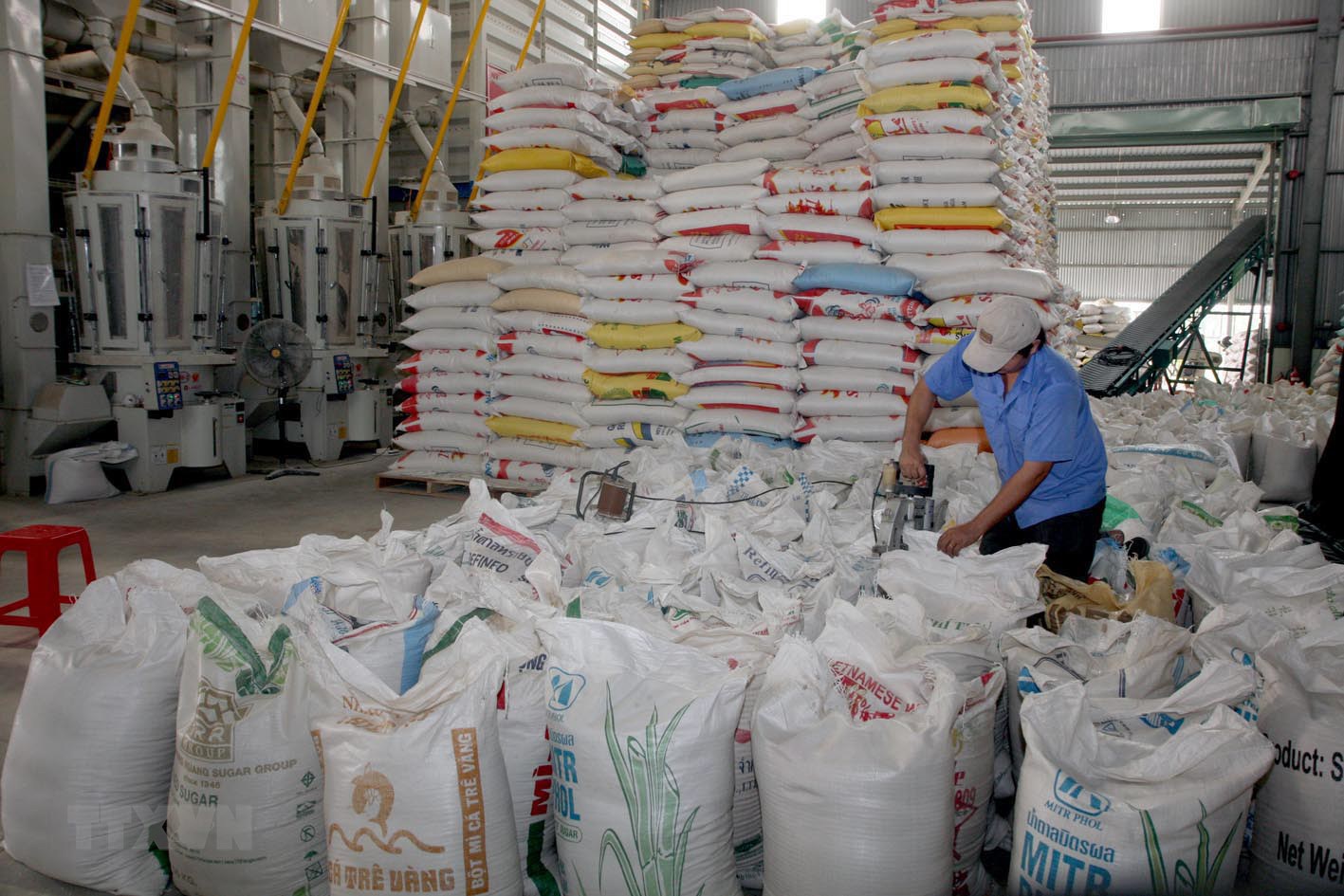Rosy outlook for rice export in 2023

Hanoi, May 3 (VNA) – Rice is one of the largest staple exports of Vietnam. Despite numerous difficulties such as climate change, geo-political uncertainties, and surging inflation, rice exports have made great strides in terms of volume and value.
In particular, with Vietnam’s export prices being the highest among rice exporting countries, experts forecast about 7 million tonnes of grain will be shipped abroad to bring home some 4 billion USD in 2023.
Doors wide open for export
In its recent report submitted to the Government, the Ministry of Industry and Trade (MoIT) said Asia was the largest regional importer of Vietnamese rice in 2022 with 4.96 million tonnes purchased, accounting for almost 71% of the total export volume and rising 15.5% year on year. Africa ranked second with nearly 1.25 million tonnes, making up 17.8% and rising 0.2% from the previous year.
Notably, despite a small proportion of about 2.45%, the export volume to Europe grew strongly, by 90.7%, from 2021 to 172,200 tonnes. Shipments to this market also generated high added value as it consumed high-quality fragrant rice.
The MoIT noted export prices have remained high in recent months, 5% broken rice is at about 450 USD per tonne, and 25% broken is at 430 USD per tonne, higher than similar varieties of major rice exporters Thailand and India.
Prices have increased sharply in early April, with 5% and 25% broken rice at 473 USD and 453 USD per tonne, respectively, up 10 USD per tonne from March 31.
The ministry said that global trading, including rice trading, has been recovering from the impacts of the COVID-19 pandemic but still facing an array of difficulties due to inflation rebounding in large markets like the US and the EU, as well as geo-political uncertainties in the world.
Thanks to the Government and Prime Minister’s attention and measures taken by ministries, rice production and exports have recorded encouraging outcomes, according to the MoIT.
Rice exports have been governed in a way that purchases all the grain produced by farmers and guarantees their interests, thus helping stabilise domestic milled and unmilled rice prices.
Export structure has adhered to a defined plan, with white rice holding a stable proportion, under 45% of total export volume, and fragrant rice and glutinous rice over 45%.
In spite of a modest volume, the overseas shipment of organic rice and micronutrient-fortified rice has also helped diversify export varieties and affirm the grain’s export value.
Improving produce quality
Tran Thanh Hai, Deputy Director of the MoIT’s Foreign Trade Agency, said Vietnam produces about 22 - 23 million tonnes of milled rice each year, about 15% of which is shipped abroad.
Therefore, there is plenty of room for increasing the export volume. Particularly, with over 80% of the production being fragrant and high-quality rice, more opportunities are being opened up for the industry to develop further.
In 2022, despite numerous difficulties, the rice industry maintained good growth. Notably, exports increased in both value and volume and at times, the price of Vietnamese rice was the world’s highest. This outcome showed the success of the agricultural sector in shifting to producing high-quality rice.
Hai noted ministries and sectors have also assisted businesses to seek new varieties and expand farming zones to improve rice quality, with a focus on high-quality and fragrant rice.
Among external factors, India still maintains a rice export ban, causing a scarcity in the global market. Meanwhile, demand in such countries as China, the Philippines, and Indonesia is bouncing back.
In particular, though the volume shipped to Indonesia remains modest, export growth is high, making the archipelago nation a highly potential market for Vietnamese rice, especially when this country plans to import 2 million tonnes of rice for the national reserve in 2023.
Experts said thanks to good production capacity, rice supply for export will be stable. As many countries, especially traditional markets like China and the Philippines, are also stepping up imports, exports can hit some 7 million tonnes to bring home nearly 4 billion USD this year.
The MoIT also forecast rice shipments can reach 7 million tonnes thanks to the return of such markets as Indonesia and Bangladesh, and China’s reopening after the pandemic.
Nguyen Phuc Nam, Deputy Director of the MoIT’s Asia - Africa Market Department, predicted that rice exports will stay smooth, perceiving that in the short term, prices will remain good as global economic and political uncertainties will boost food stockpiling demand.
Echoing the view, Nguyen Viet Anh, General Director of the Phuong Dong (Orient) Rice Co. Ltd, said rice prices are expected to stay high because many countries, including the Philippines, China, and Indonesia, are buying the grain to raise their national reserves.
However, despite favourable conditions in terms of markets, enterprises are facing difficulties in terms of capital and proposing that the State Bank of Vietnam order commercial banks to facilitate access to capital, especially as harvest nears for the winter-spring crop.
There is a number of latent challenges to rice exports as market diversification strategies remain limited. Export markets are not yet considered sustainable as Vietnam still depends on traditional buyers like China and the Philippines - the biggest market, which imports over 45% of Vietnam’s total shipments.
Notably, Vietnamese rice is also facing competition from cheap supply sources such as India and Pakistan while production costs are soaring as a result of escalating input expenses.
In addition, though international transport fees have declined since 2021, they are still high, particularly since the Russia - Ukraine conflict broke out. This fact is causing pressure on exporters worldwide.
Given this, aside from assistance from the MoIT, businesses also need to improve rice quality and meet phytosanitary and origin tracing standards to optimise preferential treatment under free trade agreements to foster exports, according to insiders./.





